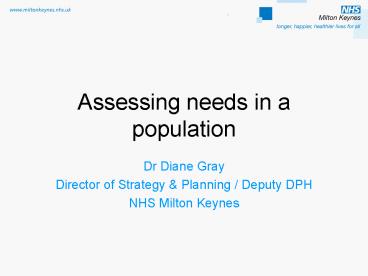Assessing needs in a population PowerPoint PPT Presentation
1 / 24
Title: Assessing needs in a population
1
Assessing needs in a population
- Dr Diane Gray
- Director of Strategy Planning / Deputy DPH
- NHS Milton Keynes
2
To come ...
- Technical definitions the what
- Being strategic whats the business the why
- The how
- Information sources
- Information analysis
- Using the information
- And the not quite sorted yet ...
- QA
3
The what
- Definition of Competency 5
- Manage knowledge and undertake robust and
regular needs assessment - Analytical skills and insight
- Understanding of health needs trends
- Use of health needs benchmarks
- Definition of health needs assessment (Stevens
and Raftery) - Epidemiological
- Comparative
- Corporate
4
Important distinctions
5
The why
- Would I let my mother / best friend / child use
this service? - If I was paying for this service from my own
money, would I?
6
Health inequalities mind the gapDifference in
expectation of life by ward from MK average,
2004-8
7
Gap is caused by a few key conditions
Life expectancy years gained if the most deprived
quintile of Milton Keynes had the same mortality
rate as the England average for each cause of
death
8
The howdeterminants of health Need
9
- www.mkiobservatory.org.uk
10
(No Transcript)
11
(No Transcript)
12
(No Transcript)
13
(No Transcript)
14
(No Transcript)
15
The how use of healthcare Demand
- QOF prevalence, outcomes, exceptions
- Child health vaccinations, obesity
- Hospital activity data
- Prescribing data
- Data from community services ...
16
Tell the story Practice profiles
17
Tell the story Social atlas
18
QualityMK a whole system approach to quality
improvement
- To create a self-improving system
- that makes a reality of
- 3 widely used slogans
- Evidence based
- Primary care led
- Patient engagement
19
Using the information maternity care
- Identified as high cost, poor outcomes in
Strategic Plan - High perinatal mortality rate (altho not
statistically significant) - Rising caesarean section rates
- Consistently in Top 10 PCTs in programme
budgeting - High number of complaints
- Public health led a 6 month service review
- Service spec written and agreed in hospital
contract - Quality review group (including public health)
monitors outcomes - Much tighter links with communities and health
promotion
20
Using the information urgent care
- Identified as high cost, high volume, low
satisfaction in Strategic Commissioning Plan - Significant proportion of patients bounced
between providers - Default to AE no change in activity even with
new WiC - Public health set the vision
- Use Big Brands, dont compete against them
- Integrate around the patient, not around the
services - Self-care is a therapeutic option!
- Procurement led by Contracts with input from
public health, PBC, PEC, patients - Key indicators include health outcomes
21
Using the information diabetes
- Identified as high cost, high volume, low
satisfaction in Strategic Commissioning Plan - Low QOF scores with high exceptions
- High emergency admission rates for diabetes
complications - High programme budget spend
- High number of complaints
- Public health set the vision
- Skill up primary care
- Redefine role of secondary care
- Embrace Care Planning Approach
- Roll-out across practices now underway
22
Summary
- Dont tick the box and miss the point
- Do remember that Healthcare ? Health
- Less is most certainly more
- Data is not the same as information
- Information is only useful if its used ...
23
The not quite sorted yet
- Timeliness of data (especially national datasets)
- Sharing data
- Different denominators
- Modelling and predicting
- Using sensible and shared assumptions
- Health economics
- Programme budgeting as a blunt instrument
24
QA
- The role of joint intelligence units
- Joint with who?
- Possession is 9/10s the law
- Flexibility and responsiveness
- Creating a JSNA
- How to define the right questions
- Link with the Public Health Annual Report and the
Childrens Young Peoples Plan - Finding the right benchmarks
- What are health needs benchmarks
- Timely production of comparisons
- How to make them accessible

